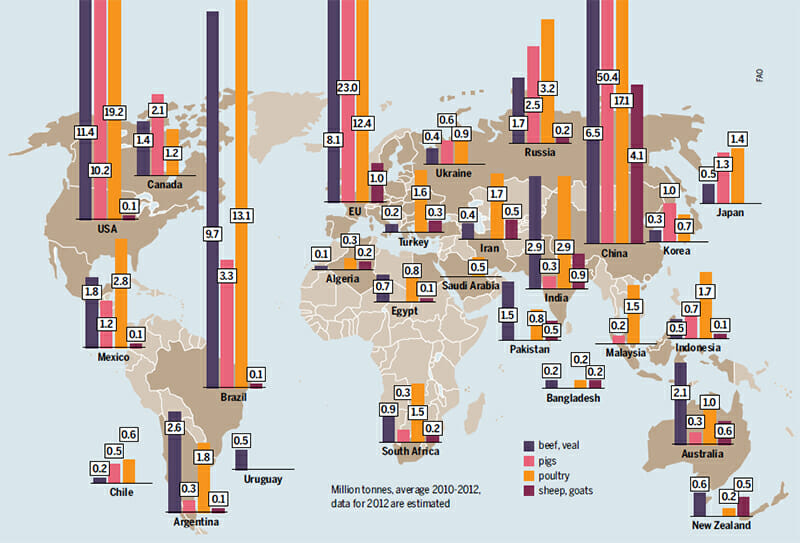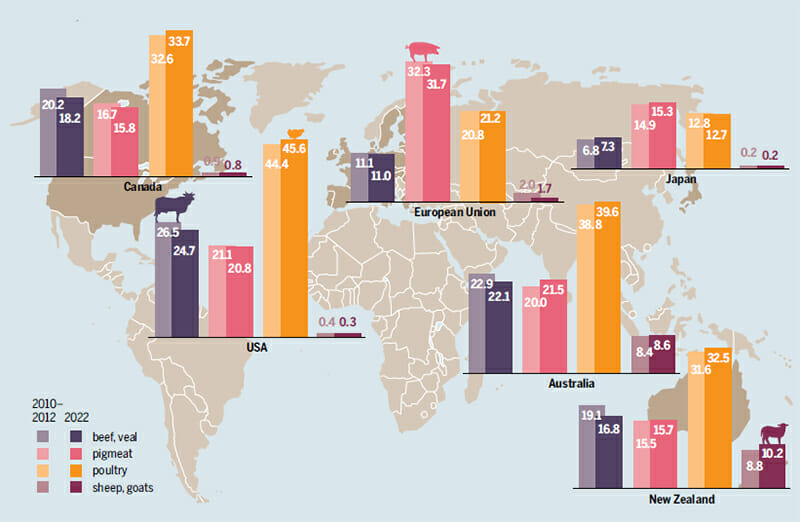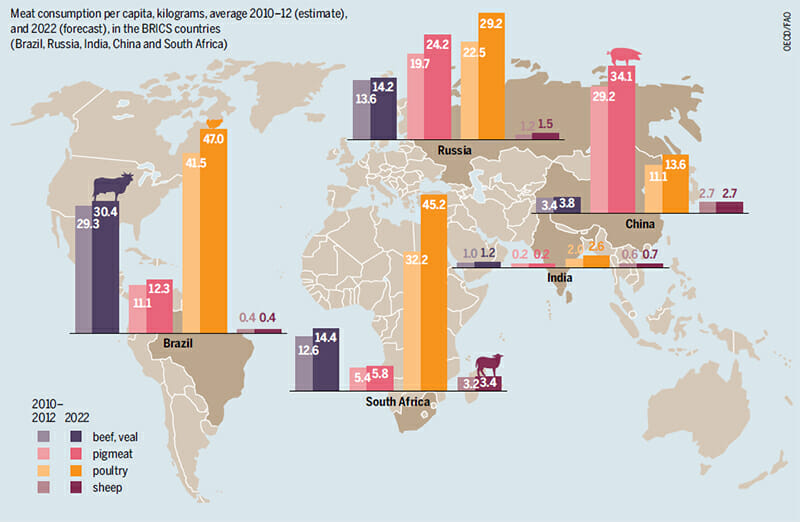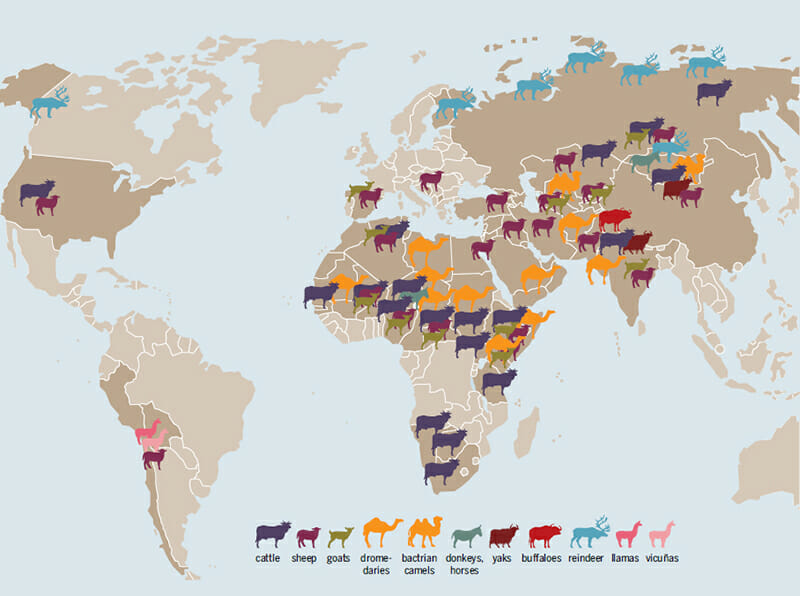4 Fascinating Maps from the New Meat Atlas
The new Meat Atlas, from a pair of European non-profits, is stacked full of interesting information about the future of meat consumption — and lots of beautiful maps. Here’s four of our favorites.
4 Fascinating Maps from the New Meat Atlas
The new Meat Atlas, from a pair of European non-profits, is stacked full of interesting information about the future of meat consumption — and lots of beautiful maps. Here’s four of our favorites.


Meat production is up worldwide, but not in the expected ways or places. As a global trend, chicken and pork are taking up a larger share of the world’s meat supply while lamb and beef herds decline. The reason? As the world moves toward practices of industrial agriculture, it needs animals with a high feed efficiency that can be fit into small spaces. Birds and pigs fit the bill.
During Sheep Week, we at Modern Farmer wrote much about the perils of lamb, but I had a hard time believing the global decline of beef production reported in the atlas. While the U.S. remains the world’s largest beef producer, the industry expects a 4 to 6 percent decline in production numbers over 2013. Other big-time beef producers like Brazil and Canada are also bringing less meat to market.
India, strangely, is a bright spot for the beef industry, as buffalo meat production has doubled between 2010 and 2013, making the subcontinent the world’s largest beef exporter.
So as world meat production doubles by 2050, expect to hear much more oinking and clucking than mooing and baaing.

Has the developed world reached peak meat? In the U.S., meat consumption dropped 9 percent from 2007 to 2013. Germans ate 5 pounds less meat per person in 2012 than they did into 2011. The industry blames it on a cold summer killing the barbecue season, while others point to trending low-meat diets and health concerns. Whatever the cause, meat consumption patterns leave the rising demand to the developing economies of India and China.

A rise in population and rapid urbanization has driven and increasing demand for meat in the so-called BRICS (Brazil, Russia, Indian, China, and South Africa). Between 2003 and 2012, their meat consumption rate rose 6.3 percent a year, and is expected to keep growing at a steady pace through the decade.
To meet the demand, says the atlas, “factory farms, similar to those known in the industrialized world since the 1950s, will have to be established everywhere.” Those future farms will require an enormous increase in feed grains like soybeans, which will have to double in yield by 2050.

All told, the shifts are leading to huge changes in the ways the world raises animals. The atlas identifies two groups — smallholders and pastoralists — that could drown under a wave of industrialized animal husbandry, even as their methods hold the promise of a healthy environment. Smallholders are farmers who raise a small number of animals in conjunction with a small number of crops. Pastoralists, better known as herders, tend to specialize in converting scrublands into animal protein through migratory herding. The atlas recognizes a fair amount of overlap between those two groups.
Future demand for meat might not mean a complete embrace of industrial methods. Radical ideas — like cricket farming or lab grown meat — could play a role in meeting skyrocketing demand for animal protein. But time and again, the beautiful maps in the meat atlas beg a single question: Is cheap meat really worth it?
Follow us
This work is licensed under a Creative Commons Attribution-NoDerivatives 4.0 International License.
Want to republish a Modern Farmer story?
We are happy for Modern Farmer stories to be shared, and encourage you to republish our articles for your audience. When doing so, we ask that you follow these guidelines:
Please credit us and our writers
For the author byline, please use “Author Name, Modern Farmer.” At the top of our stories, if on the web, please include this text and link: “This story was originally published by Modern Farmer.”
Please make sure to include a link back to either our home page or the article URL.
At the bottom of the story, please include the following text:
“Modern Farmer is a nonprofit initiative dedicated to raising awareness and catalyzing action at the intersection of food, agriculture, and society. Read more at <link>Modern Farmer</link>.”
Use our widget
We’d like to be able to track our stories, so we ask that if you republish our content, you do so using our widget (located on the left hand side of the article). The HTML code has a built-in tracker that tells us the data and domain where the story was published, as well as view counts.
Check the image requirements
It’s your responsibility to confirm you're licensed to republish images in our articles. Some images, such as those from commercial providers, don't allow their images to be republished without permission or payment. Copyright terms are generally listed in the image caption and attribution. You are welcome to omit our images or substitute with your own. Charts and interactive graphics follow the same rules.
Don’t change too much. Or, ask us first.
Articles must be republished in their entirety. It’s okay to change references to time (“today” to “yesterday”) or location (“Iowa City, IA” to “here”). But please keep everything else the same.
If you feel strongly that a more material edit needs to be made, get in touch with us at [email protected]. We’re happy to discuss it with the original author, but we must have prior approval for changes before publication.
Special cases
Extracts. You may run the first few lines or paragraphs of the article and then say: “Read the full article at Modern Farmer” with a link back to the original article.
Quotes. You may quote authors provided you include a link back to the article URL.
Translations. These require writer approval. To inquire about translation of a Modern Farmer article, contact us at [email protected]
Signed consent / copyright release forms. These are not required, provided you are following these guidelines.
Print. Articles can be republished in print under these same rules, with the exception that you do not need to include the links.
Tag us
When sharing the story on social media, please tag us using the following: - Twitter (@ModFarm) - Facebook (@ModernFarmerMedia) - Instagram (@modfarm)
Use our content respectfully
Modern Farmer is a nonprofit and as such we share our content for free and in good faith in order to reach new audiences. Respectfully,
No selling ads against our stories. It’s okay to put our stories on pages with ads.
Don’t republish our material wholesale, or automatically; you need to select stories to be republished individually.
You have no rights to sell, license, syndicate, or otherwise represent yourself as the authorized owner of our material to any third parties. This means that you cannot actively publish or submit our work for syndication to third party platforms or apps like Apple News or Google News. We understand that publishers cannot fully control when certain third parties automatically summarize or crawl content from publishers’ own sites.
Keep in touch
We want to hear from you if you love Modern Farmer content, have a collaboration idea, or anything else to share. As a nonprofit outlet, we work in service of our community and are always open to comments, feedback, and ideas. Contact us at [email protected].by Sam Brasch, Modern Farmer
February 13, 2014
Modern Farmer Weekly
Solutions Hub
Innovations, ideas and inspiration. Actionable solutions for a resilient food system.
ExploreExplore other topics
Share With Us
We want to hear from Modern Farmer readers who have thoughtful commentary, actionable solutions, or helpful ideas to share.
SubmitNecessary cookies are absolutely essential for the website to function properly. This category only includes cookies that ensures basic functionalities and security features of the website. These cookies do not store any personal information.
Any cookies that may not be particularly necessary for the website to function and are used specifically to collect user personal data via analytics, ads, other embedded contents are termed as non-necessary cookies.